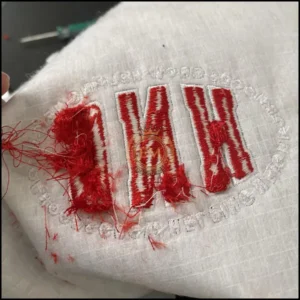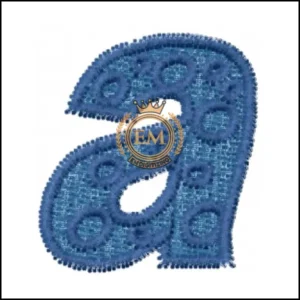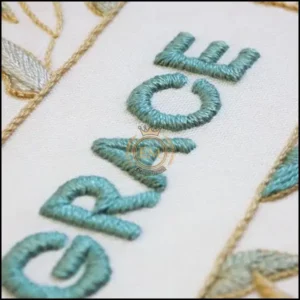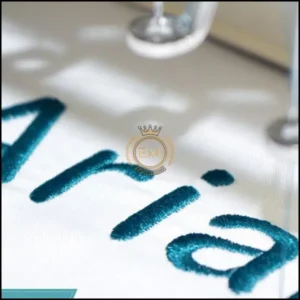When you become an expert in creating block and cursive letters embroidery, you may find a new problem which is small embroidery fonts.
But you don’t need to worry because we’re here to help you create small embroidered letters and get high-quality results.

5 Tips For Small Embroidery Fonts to Get the Best Results
What Are Small Embroidery Fonts?
Small embroidery letters are just like the name: small fonts. There are lots of tiny fonts available for machine embroidery. You can use them in different ways like for logos or patches.
When you’re using them you need to consider material use, font size, and number of letters in design. However, small embroidered letters are hard to use because you need accuracy and precision in embroidery to get clear results.
Some customers want the same small fonts on their t-shirts that they see on printed items. But as an embroiderer, you must guide them on which size and fonts work best.
What Are The Problems You Might Face With Small Embroidery Fonts?
When you embroider letters on a shirt that is in small size you can face these problems:
Bird Nesting
This issue occurs when there are many stitches in a small area. These cause the needle to be stuck or trapped in the thread.
If you want to know more reasons which cause bird nesting then read our blog by clicking here.

Risk Of Holes:
You may create holes in the fabric when your embroidery has so many small stitches in a circular design. This is not acceptable if you’re embroidering small embroidery letters on polo shirts.

Hard To Read:
If you have a lot of small stitches in a small area, it makes the text difficult to read. This occurs especially when using cotton fabric or another type of fabric that can shrink because it makes the issue worse.
But with the right tools and techniques, you can get the best results when using small embroidery fonts.
5 Tips For Using Small Embroidery Fonts:
Some of you may think that we keep talking about bad news….Right?
Now, it’s time for good news!
If you want high-quality stitch lettering font you need to make smart choices about your stabilizer, fabric, font style, and font size.
Let’s talk about some factors that can influence your final design.
1. Fabric Types For Small Embroidery Letters:
Knite fabric is thicker and breathable making it useful for sports shirts. You can also call it honeycomb weaves because sometimes it can be challenging to embroider on this and stitches sink into the fabric.
Slippery fabrics like silk can also hard to embroider small letters because they don’t have enough stability and can alter the shape of letters. We also suggest you avoid using sheer fabric like a net.
Pro Tip: If the fabric is stable you can easily embroider on it. You can use woven fabric because it has high stability and works great for tiny fonts.
Check out our blog if you want to explore the best fabric for embroidery.
2. Style Considerations For Letters:
When considering the letters for embroidery digitizing there is a thumb rule: if the detail is less the result is better. You need to consider this especially when you’re making small embroidery designs.

We know that embroidering bold or swirl fonts is enjoyable but when you’re embroidery small letters we suggest you go with basic font because it gives you more precise results.
Moreover, when choosing small embroidery fonts we recommend using block letters rather than cursive because they’re more readable.
The smallest size of text is about 3mm to 4mm typically and you have to keep in mind that if the size is so small it is hard to read.
3. Use The Right Type Of Stabilizer And Underlay:
When working with small embroidery fonts you must underlay your fabric.
Let’s first talk about what is underlay in machine embroidery.
Well, it’s like a foundation on your embroidery pattern. You can apply it in different ways because it provides the same functions: it keeps the design in place and prevents distortion.
There are a few things you must remember when underlay the fabric, especially for tiny fonts.
- For tiny fonts, it is recommended to apply underlay in the center because it supports the design to stick on top of the fabric.
- Try to avoid using edge run on small fonts because it doesn’t provide enough stability.
- You can also use knockdown stitches because they’re also a type of underlay. It appears like a tatami stitch and works best when embroidered on fluffy fabric like towels.
When using an underlay you must keep the less density of stitches. Believe us “less is more”. It is advisable to keep density as a fault so you can get high-end results.
But when we talk about stabilizers you follow this rule: more stabilizer means better embroidery. We recommend you apply at least two layers of stabilizer.
To read more about the stabilizer in embroidery check out our blog.
4. Small Embroidery Font Needle And Thread Recommendations:
You should use a small size of needle when you’re embroidering tiny fonts. Because when a small needle passes through the fabric it leaves small holes. The selection of needles also depends on the type of fabric you’re using.
If you’re working with knit fabric you should choose a ballpoint needle. On the other hand, when using woven fabric you should go with a sharp pointed needle because it penetrates deeply into the fabric and gives embroidery a long-lasting finish.
The size of the embroidery thread also influences the quality. So, for small embroidery fonts, we suggest going with a 60-weight thread. But try it in a spare fabric to see how it looks before embroidering on the actual fabric.
Let’s understand this with an example in which we compare 40 and 60-weight thread to embroider with 75/11 and 65/9 size needles.
Standard block font is embroidered on cotton woven fabric with 40-weight thread and tear-away stabilizer.
And, now have a look at this image in which the same embroidery fonts are embroidered with 60-weight fabric on the same material.
Now, you can see a clear difference in how the weight of the thread and needle size affect the quality.
Remember: Slow down the machine’s speed because the thread pulling is less and stitching becomes more even.
5. Stitch Length And Density Of Small Embroidery Fonts:
As an expert digitizer, we recommend not to change the design of tiny fonts and use them as it is in digitized design. If the density is under 0.25mm it covers all the fabric and eventually makes a hole.

You can also raise the pull compensation if you want. But you’ve to be careful not to increase too much because it makes the design unreadable. Also, you should set the stitch length to at least 1mm or leave the default stitch length as it is.
For instance, if you want to prevent holes in an opening letter like “e” set the stitch length to 1mm.
Bottom Line:
Practice and patience are key to getting the best result when using small embroidery fonts. But you must remember some key points. First, slow down the embroidery machine’s speed which prevents distortion.
Second, choose the right fabric and stabilizer that works great for small letters. Lastly, use a small needle and 60-weight thread so you can get more accurate results.
If you’re still facing issues using small fonts we’re here to guide you.
You can also hire us to digitize small letters in embroidery with high-end results. We convert your designs into an embroidery file that is compatible with your machine without any errors.
We offer our first-time customers a 50% discount on all of our services, plus a free quote that is generated in less than 5 minutes.
You can contact us and ask any questions about this article, and don’t forget to share it with people you think might find it useful.
Best of luck to you!
Thank you so much for reading!
Frequently Asked Questions:
The best font for small letters in embroidery is Futura Condensed which is mostly used in monograms or logos. It has a modern and clean appearance that works great for many types of designs.
- Comic Sans Regular
- Arial Black
- Baskerville Regular
- Caslon 3 Regular
- Alternate Gothic Regular
- Gotham Regular
Polyneon 60 is best for small fonts in embroidery to have fine detail. Also, make sure to use 65/9 size needles and increase the stitch density.
The suggested size of the embroidery font is 2 inches. But for closed letters like b, d, and p the font size must be at least 0.2 inches to give a readable finish.
Roboto font style is best for small fonts because they’re readable at the smallest size and don’t even lose their elegance.
